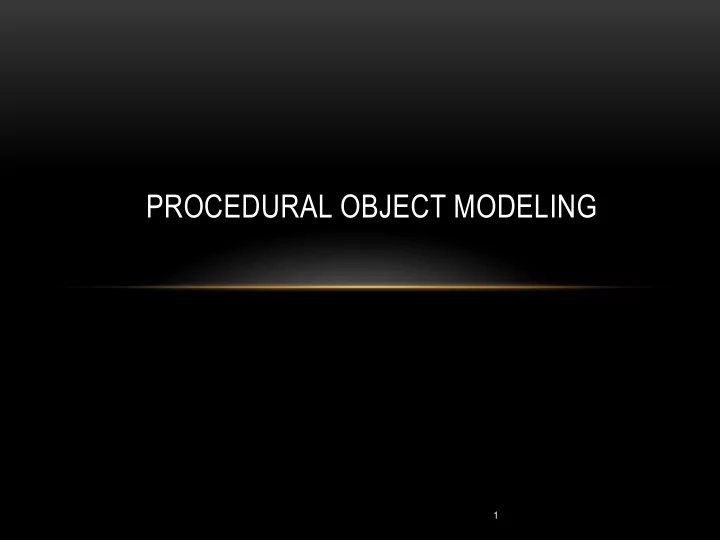

PROCEDURAL OBJECT MODELING 1
OUTLINE • Building a Sphere • Building a Torus 2
A SPHERE!! • Specifying vertices by hand is tedious Some objects are better represented mathematically • • These are better expressed algorithmically
STRATEGY • Select a “precision” The number of horizontal slices in the sphere • • Subdivide horizontal / circular slices into points Group vertices into triangles • Select texture coordinates to wrap the sphere with •
ONE MORE STEP IN THE STRATEGY • Generate normal vectors We’re not using these yet, but we will when we get to lighting •
STORING OBJECT VERTICES • Recall storing cube vertices Even though each vertex participated in several triangle primitives, we stored each • vertex associated with each primitive • Vertices end up getting stored several times • OK for cubes, but more complex models will require too much storage Instead, we can store each vertex once • • In the case of the sphere, start with bottom horizontal slice and store in array Use indices into this array to access each triangle primitive • • End up with array of vertices and array of indices into vertex array
TRAVERSING VERTICES • Start at the bottom of the sphere Traverse vertices in a circular fashion • • Build triangle primitives from each square region above and to the right
THE CODE TO CREATE A SPHERE CLASS public class Sphere { private int numVertices, numIndices, prec=48; private int[] indices; private Vertex3D[] vertices; public Sphere(int p) { prec = p; InitSphere(); } …
THE SPHERE CODE … private void InitSphere() { numVertices = (prec+1) * (prec+1); numIndices = prec * prec * 6; vertices = new Vertex3D[numVertices]; indices = new int[numIndices]; for (int i=0; i<numVertices; i++) { vertices[i] = new Vertex3D(); } …
THE SPHERE CODE … … // calculate triangle vertices for (int i=0; i<=prec; i++) { for (int j=0; j<=prec; j++) { float y = (float) cos(toRadians(180-i*180/prec)); float x = -(float) cos(toRadians(j*360.0/prec))*(float)abs(cos(asin(y))); float z = (float) sin(toRadians(j*360.0f/(float)(prec))) *(float)abs(cos(asin(y))); vertices[i*(prec+1)+j].setLocation( new Point3D(x,y,z)); vertices[i*(prec+1)+j].setS(( float)j/prec); vertices[i*(prec+1)+j].setT(( float)i/prec); vertices[i*(prec+1)+j].setNormal( new Vector3D(vertices[i*(prec+1)+j].getLocation())); } } …
THE SPHERE CODE … … // calculate triangle indices for(int i=0; i<prec; i++) { for(int j=0; j<prec; j++) { indices[6*(i*prec+j)+0] = i*(prec+1)+j; indices[6*(i*prec+j)+1] = i*(prec+1)+j+1; indices[6*(i*prec+j)+2] = (i+1)*(prec+1)+j; indices[6*(i*prec+j)+3] = i*(prec+1)+j+1; indices[6*(i*prec+j)+4] = (i+1)*(prec+1)+j+1; indices[6*(i*prec+j)+5] = (i+1)*(prec+1)+j; } } } …
THE SPHERE CODE … … public int[] getIndices() { return indices; } public Vertex3D[] getVertices() { return vertices; } }
USING THE SPHERE CLASS • In init(): mySphere = new Sphere(precision); In display(): • int numVers = mySPhere.getIndices().length; gl.glDrawArrays(GL_TRIANGLES, 0, numVerts);
USING THE SPHERE CLASS private void setupVertices() { GL4 gl = (GL4) GLContext. getCurrentGL(); Vertex3D[] vertices = mySphere.getVertices(); int[] indices = mySphere.getIndices(); float[] pvalues = new float[indices.length*3]; float[] tvalues = new float[indices.length*2]; float[] nvalues = new float[indices.length*3]; for (int i=0; i<indices.length; i++) { pvalues[i*3] = ( float) (vertices[indices[i]]).getX(); pvalues[i*3+1] = ( float) (vertices[indices[i]]).getY(); pvalues[i*3+2] = ( float) (vertices[indices[i]]).getZ(); tvalues[i*2] = ( float) (vertices[indices[i]]).getS(); tvalues[i*2+1] = ( float) (vertices[indices[i]]).getT(); nvalues[i*3] = ( float) (vertices[indices[i]]).getNormalX(); nvalues[i*3+1]= ( float)(vertices[indices[i]]).getNormalY(); nvalues[i*3+2]=( float) (vertices[indices[i]]).getNormalZ(); } …
USING THE SPHERE CLASS … gl.glGenVertexArrays(vao.length, vao, 0); gl.glBindVertexArray(vao[0]); gl.glGenBuffers(3, vbo, 0); gl.glBindBuffer( GL_ARRAY_BUFFER, vbo[0]); FloatBuffer vertBuf = Buffers. newDirectFloatBuffer(pvalues); gl.glBufferData( GL_ARRAY_BUFFER, vertBuf.limit()*4, vertBuf, GL_STATIC_DRAW); gl.glBindBuffer( GL_ARRAY_BUFFER, vbo[1]); FloatBuffer texBuf = Buffers. newDirectFloatBuffer(tvalues); gl.glBufferData( GL_ARRAY_BUFFER, texBuf.limit()*4, texBuf, GL_STATIC_DRAW); gl.glBindBuffer( GL_ARRAY_BUFFER, vbo[2]); FloatBuffer norBuf = Buffers. newDirectFloatBuffer(nvalues); gl.glBufferData( GL_ARRAY_BUFFER, norBuf.limit()*4,norBuf, GL_STATIC_DRAW); }
THE RESULT Note: The previous code still stored vertices in the VBO redundantly
BUILDING A TORUS – USING OPENGL INDEXING • Approach: Define a radius about the origin (inner radius) • • Build a circle around that radius • Radius of circle is outer radius • Rotate around the origin and build more circles Generate texture coordinates and normal as we go •
OPENGL INDEXING • Use an additional VBO to store indices (in setupVertices()): gl.glBindBuffer( GL_ELEMENT_ARRAY_BUFFER, vbo[3]); // indices IntBuffer idxBuf = Buffers. newDirectIntBuffer(indices); gl.glBufferData( GL_ELEMENT_ARRAY_BUFFER, idxBuf.limit()*4, idxBuf, GL_STATIC_DRAW); • In display(), use glDrawElements instead of glDrawArrays: int numIndices = myTorus.getIndices().length; gl.glBindBuffer( GL_ELEMENT_ARRAY_BUFFER, vbo[3]); gl.glDrawElements( GL_TRIANGLES, numIndices, GL_UNSIGNED_INT, 0);
THE RESULT
SUMMARY • Building a Sphere • Building a Torus 20
Recommend
More recommend